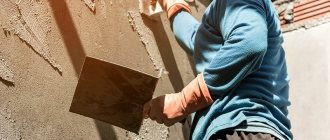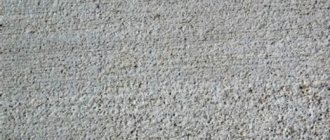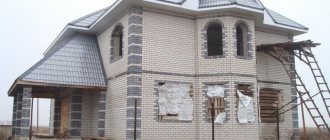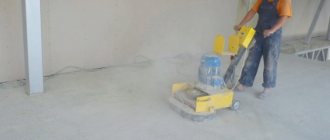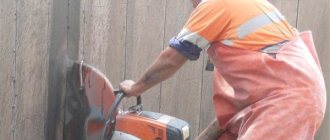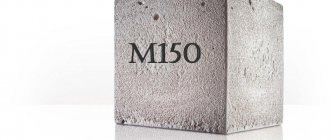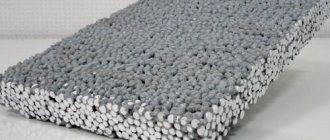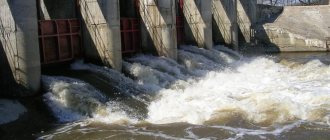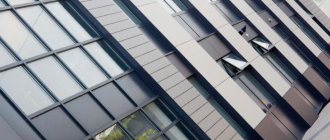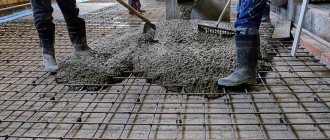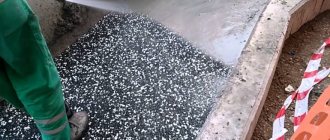TECHNICAL REQUIREMENTS
1.1. Requirements for concrete
1.1.1. The quality of silicate concrete must meet the requirements of this standard and ensure the manufacture of products that meet the requirements of state standards and technical specifications for these products.
1.1.2. In terms of compressive strength, silicate concrete according to the CMEA 1406-78 standard is characterized by the following classes: B5, B7.5, B10, B12.5, B15, B20, B25, B30, B35, B40, B45, B50, B55, B60.
Note. For structures designed without taking into account the requirements of the CMEA 1406-78 standard, the compressive strength of concrete is characterized by the following grades: M75, M100, M125, M150, M200, M250, M300, M350, M400, M450, M500, M600, M700.
1.1.3. Based on frost resistance, water resistance and average density (volumetric mass), the following grades are established:
in terms of frost resistance - Mrz 35, Mrz 50, Mrz 75, Mrz 100, Mrz 150, Mrz 200, Mrz 300, Mrz 400, Mrz500, Mrz 600;
for water resistance - B2, B4, B6, B8, B10;
by average density (volumetric mass) - Pl1000, Pl1100, Pl1200, Pl1300, Pl1400, Pl1500, Pl1600, Pl1700, Pl1800, Pl1900, Pl2000, Pl2100, Pl2200, Pl2300, Pl2400.
1.1.4. Concrete mixtures must comply with the technical requirements of GOST 7473-76.
1.1.5. The tempering strength of silicate concrete in products must be equal to the grade specified by the project.
1.1.6. The abrasion rates of silicate concrete with dense aggregates, established in standards or technical specifications for specific types of products, should not exceed:
0.7 g/ - for products operating in conditions of high traffic intensity (for example, slabs for covering roads and sidewalks on main streets);
0.8 g/ - for products operating in conditions of average traffic intensity (for example, elements of stairs of public and industrial buildings and structures, floor slabs in underground pedestrian crossings);
0.9 g/ - for products operating in conditions of low traffic intensity (for example, elements of stairs of residential buildings, slabs for covering sidewalks in intra-block driveways).
1.2. Material requirements
1.2.1. The materials used to prepare silicate concrete must meet the requirements of standards or technical specifications for these materials and ensure that concrete obtains the specified technical characteristics.
1.2.2. The following finely ground mixtures obtained by grinding the components together must be used as a binder:
calcareous-siliceous, consisting of lime and sand (quartz or quartz-feldspathic);
lime-slag, consisting of metallurgical slag and lime;
lime-ash, consisting of lime and fuel ash (coal, oil shale);
lime-agloporite, lime-expanded clay, lime-shungizite, etc., consisting of lime and waste from the production of artificial porous aggregates;
lime-belite, consisting of products of low-temperature firing of calcareous-siliceous mixture and sand or belite (nepheline) sludge and sand.
1.2.3. The following should be used as fillers for silicate concrete:
natural and crushed sands according to GOST 8736-77 and GOST 10268-80;
crushed stone from blast furnace slag according to GOST 5578-76;
agloporite crushed stone and sand according to GOST 11991-76;
expanded clay gravel and sand according to GOST 9759-76;
shungizite gravel according to GOST 19345-73;
crushed stone and porous sand from metallurgical slag (slag pumice) - according to GOST 9760-75.
Coarse aggregates should be used with a grain size of no more than 20 mm.
1.2.4. To regulate the properties of silicate binder, concrete mixture and concrete, the following additives are used:
gypsum stone according to GOST 4013-74 - to slow down the hydration of lime;
surfactant lye (PASH-1);
synthetic plasticizing additive (SPD);
sulfite-yeast mash (SDB);
organosilicon liquids GKZh-10 and GKZh-11 - to improve the workability and air entrainment of the concrete mixture.
A list of technical specifications and industry standards is given in Reference Appendix 2.
1.2.5. It is allowed to use other materials and additives during a feasibility study and ensuring the durability of silicate concrete.
1.2.6. Water for preparing silicate concrete must meet the requirements of GOST 23732-79.
1.3.Technology requirements
1.3.1. Products from silicate concrete are made, as a rule, using equipment intended for the production of concrete and reinforced concrete products using a cement binder. Other equipment may be used. In this case, it must be ensured that the products have the specified technical parameters.
Concrete mixtures should be prepared in forced mixers.
1.3.2. Heat and moisture treatment of molded products made of silicate concrete should be carried out in autoclaves at a pressure of, as a rule, 9-13 kgf / according to the following regime:
| rise in temperature………………………………………………………. | 2-6 hours |
| isothermal exposure at a temperature of 175-190°C………… | 4-8 hours |
| decrease in temperature………………………………………………………. | 2-3 hours |
1.3.3. Heat and moisture treatment modes should be specified depending on the properties of the materials used and specific production conditions.
1.3.4. Before starting the production of silicate concrete products, it is necessary to select the composition of the binder, concrete mixture and modes of mixing and compacting concrete in order to establish optimal consumption of materials and technology parameters.
1.3.5. Technological regimes for the preparation of silicate concrete and the manufacture of products from it must be set out in enterprise standards or technological maps approved in the prescribed manner.
History[ | ]
See also: Roman concrete
Concrete has been known for over 4000 years (Ancient Mesopotamia) [ source not specified 1163 days
], was especially widely used in Ancient Rome[1][approx. 1]. Italy is a volcanic country where components from which concrete can be made are readily available, including pozzolans and crushed lava stones. The Romans used concrete in the massive construction of public buildings and structures, including the Pantheon, whose dome is still the largest in the world made of unreinforced concrete. At the same time, this technology was not widespread in the eastern part of the state, where stone was traditionally used in construction, and then cheap plinth - a type of brick.
Due to the decline of the Western Roman Empire, large-scale construction of monumental buildings and structures came to naught, which made the use of concrete impractical and, combined with the general degradation of crafts and science, led to the loss of the technology for its production. During the early Middle Ages, the only major architectural objects were cathedrals, which were built from natural stone.
Modern concrete based on a cement binder has been known since 1844 (I. Johnson). Joseph Aspdin received a patent for Portland cement in 1824; James Parker received a patent for “Roman cement” in 1796.
The world leaders in concrete production are China (430 million m³ in 2006)[2] and the USA (345 million m³ in 2005[3] and 270 million m³ in 2008)[2]. In Russia in 2008, 52 million m³ were produced.
CONTROL AND TEST METHODS
2.1. Materials for the preparation of silicate concrete must be tested in accordance with the requirements established by the current standards for their testing methods.
2.2. Technical characteristics of silicate concrete are determined in accordance with the requirements of the following state standards:
compressive strength - according to GOST 10180-78 and GOST 18105.1-80;
density (bulk weight) - according to GOST 12730.1-78;
frost resistance - according to GOST 10060-76;
water resistance - according to GOST 19426-74 or according to GOST 12730.5-78;
abrasion - according to GOST 13087-81;
workability of the concrete mixture - according to GOST 10181.1-81.
About cellular concrete
Cellular concrete is a type of lightweight concrete; it is obtained as a result of hardening of a mixture of binder, silica component and water, expanded with the help of a blowing agent. When the initial mixture swells, a characteristic “cellular” structure of concrete is formed with air pores evenly distributed throughout the volume. Due to this, cellular concrete has a low volumetric mass, low thermal conductivity and sufficient strength. These properties, the availability of raw materials and the simplicity of technology make cellular concrete a progressive material for effective wall structures and roofing of buildings made of lightweight reinforced concrete.
The porosity of cellular concrete is relatively easy to regulate during the manufacturing process and to obtain concrete of different volumetric masses and purposes.
According to their intended purpose, cellular concrete is divided into three groups:
- thermal insulation with a volumetric mass in the dried state of no more than 500 kg/m3;
- structural and thermal insulation (for enclosing structures) with a volumetric mass from 500 to 900 kg/m3;
- structural (for reinforced concrete) with a volumetric mass from 900 to 1200 kg/m3.
The binder for cement cellular concrete is usually Portland cement.
Cementless cellular concrete (gas and foam silicate) of autoclave hardening is made using ground quicklime of the 1st and 2nd grades with a slaking time from 8 to 25 minutes. The binder is used in conjunction with a mineral additive containing silicon dioxide.
The siliceous component (ground quartz sand, fly ash from thermal power plants and ground granulated blast furnace slag) reduces the consumption of binder and improves the quality of cellular concrete. Quartz sand is usually ground wet and used in the form of sand slurry. Grinding increases the specific surface area of the silica additive and increases its chemical activity. Finely dispersed natural quartz marshalite is found with particles ranging from 0.01 to 0.06 mm. Fly ash is highly dispersed, so it does not need to be ground. There are certain requirements for the chemical composition of ash, caused by the desire to have in the ash more of the active component - silicon dioxide and fewer substances that cause chemical corrosion or uneven volume changes. Therefore, fly ash should contain (in % by weight): SiO2 - no less than 40, Al2O3 - no more than 30, Fe2O3 - no more than 15, MgO - no more than 3, sulfur and sulfuric acid compounds (in terms of SO3) - no more 3. The presence of up to 5% of unburned coal particles in the ash is allowed. Ground granulated blast furnace slag serves as an additive to Portland cement in the production of cement cellular concrete. It can be used for the production of cementless cellular concrete with hardening activators - airborne lime and gypsum. The use of industrial waste (fly ash and blast furnace slag) for the production of cellular concrete is constantly increasing, as it is economically profitable.
It is also effective to use nepheline cement, which is obtained as a by-product of a number of industries.
The ratio between the silica component and the binder is established experimentally. The silica additive and Portland cement are usually taken equally (1:1 ratio). When mixing the materials in the mixer, the initial mixture is obtained - a dough consisting of a binder, a siliceous component and water. Swelling of the binder dough can be carried out in two ways: chemical, when a gas-forming additive is introduced into the binder dough and chemical reactions occur in the mixture, accompanied by the release of gas; mechanical, which consists in mixing the binder dough with a separately prepared stable foam.
Depending on the manufacturing method, cellular concrete is divided into aerated concrete and foam concrete. The production of mainly aerated concrete is developing here and abroad. Its technology is simpler and makes it possible to obtain a material of reduced bulk density with stable properties. Foam is not stable, which causes fluctuations in the volumetric mass and strength of concrete - foam concrete.
Aerated concrete and gas silicate. Aerated concrete is prepared from a mixture of Portland cement (often with the addition of puffed lime or caustic soda), a silica component and a gas-forming agent. Based on the type of chemical reactions, gas-forming agents are divided into the following types:
- entering into chemical interaction with the binder or its hydration products (aluminum powder);
- decomposing with the release of gas (perhydrol H202);
- interacting with each other and releasing gas as a result of exchange reactions (for example, ground limestone and hydrochloric acid).
Most often, aluminum powder . It, reacting with calcium oxide hydrate, releases hydrogen according to the reaction: 3Ca (OH)2 + 2Al + 6H20 = 3H2^ + 3CaO • Al2O3 • 6H2O. According to the chemical reaction equation, 1 kg of aluminum powder will release 1.245 m3 of hydrogen under normal conditions. As the temperature increases, the gas volume will increase and, for example, at 40°C it will be 1.425 m3. In practice, a larger amount of aluminum powder is consumed, since it contains less than 100% active aluminum and, in addition, part of the gas is lost during the process of mixing and swelling of the solution. This is taken into account using the gas retention coefficient Kg.y, which represents the ratio of the volume of gas retained by the solution, Vу to the theoretical volume of released gas Vt at a given temperature Kg.y = Vу / Vt. The gas retention coefficient is usually 0.7-0.85; To produce 1 m3 of cellular concrete with a volumetric mass of 600-700 kg/m3, 0.4-0.5 kg of aluminum powder is consumed. Calcium hydroxide is formed during the interaction of Portland cement with water during the hydrolysis of tricalcium silicate. To enhance gas evolution, airborne lime or caustic soda is added to the mixture.
Aluminum powder is used in the form of an aqueous suspension. When manufactured at a factory, aluminum powder is waxed, so its particles are poorly wetted by water. To impart hydrophilic properties to the powder, it is treated with an aqueous solution of surfactants (SSB, rosin soap, etc.). Calcination of aluminum powder in order to remove paraffin films from particles can cause an explosion.
Cellular concrete is produced using conventional (moulding) technology and other methods.
Molding technology involves casting products, as a rule, in separate forms from fluid mixtures containing up to 50-60% water by weight of dry components (water-solid ratio W/T = 0.5-0.6). When producing aerated concrete, the materials used - binder, sand sludge and water are dosed and fed into a self-propelled mortar mixer, in which they are mixed for 4-5 minutes; then an aqueous suspension of aluminum powder is poured into the prepared mixture and after subsequent mixing of the dough with aluminum powder, the aerated concrete mixture is poured into metal molds to a certain height so that after swelling the molds are filled to the top with a cellular mass. The excess mass (“top”) after the mixture has set (after 3-6 hours) cut with special strings. To accelerate gas formation, as well as the setting and hardening processes, “hot” mixtures are used in heated water with a temperature at the time of pouring into molds of about 40°C. Heat treatment of cellular concrete is carried out mainly in autoclaves in an environment of saturated water vapor at a temperature of 175-200°C and pressure 0.8-1.3 MPa. Autoclaves are hermetically sealed cylinders with a diameter of up to 3.6 m and a length of up to 32 m. In a humid environment and at elevated temperatures, the silica component exhibits chemical activity and combines with calcium hydroxide to form calcium hydrosilicates, which give cellular concrete increased strength and frost resistance.
Autoclave processing is carried out according to a certain regime, taking into account the type and massiveness of the products. To prevent cracks from appearing in products, a smooth rise and fall in temperature and pressure is provided (within 2-6 hours); The holding time of products at maximum temperature is 5-8 hours. Non-autoclaved cellular concrete, made using casting technology and hardened under normal conditions or steamed at atmospheric pressure (at a temperature of 80-100 ° C), is significantly inferior to autoclaved concrete in strength and frost resistance. Casting cellular concrete technology, based on the use of fluid mixtures with a large amount of water, has a number of disadvantages. Finished products have a high humidity of 25-30%, so they have a lot of shrinkage, causing cracks to appear. The products turn out to be non-uniform in thickness (along the height of the mold) due to the stratification of the liquid mixture and the floating of gas bubbles. The production cycle is lengthened due to the slow release of gas and setting of the mixture.
New technological methods can mitigate or completely eliminate these disadvantages.
Vibration technology of aerated concrete is that during mixing in a mixer and swelling in a mold, the mixture is subjected to vibration. Thixotropic liquefaction, which occurs as a result of weakening of the bonds between particles, makes it possible to reduce the amount of mixing water by 25-30% without compromising the workability of the mixture. In a mixture subjected to vibration, gas evolution accelerates; swelling ends within 5-7 minutes instead of 15-50 minutes with casting technology. After vibration stops, the aerated concrete mixture quickly, after 0.5-1.5 hours, acquires structural strength, allowing the product to be cut into blocks; the autoclave processing time is also reduced. All this increases the productivity of enterprises and reduces the cost of products made from cellular concrete. New technological methods have been developed for the production of cellular concrete from cold mixtures (with a temperature of about 20 ° C) with the addition of surfactants and a small amount of water. Such aerated concrete on cement, after conventional steaming at atmospheric pressure, reaches the strength of autoclaved concrete made using injection molding technology. Replacing autoclave treatment with steaming without compromising the quality of cellular concrete provides a great economic effect, since the abandonment of expensive and complex autoclave technology makes the manufacture of products cheaper and easier. The principles of vibration technology were developed by Soviet scientists.
The cutting technology for manufacturing products from cellular concrete involves first forming a large mass (volume 10-12 m3, height up to 2 m). After the concrete has gained structural strength, the mass is cut horizontally and vertically into rectangular elements and then subjected to heat treatment. The resulting elements are calibrated on a special milling machine and their façade surfaces are finished. From the finished elements, which have precise dimensions, flat or three-dimensional structures are assembled with glue using tie rods. In this way, large wall panels the size of one or two rooms and the height of a floor are obtained. Cutting technology makes it possible to produce lightweight prefabricated structures with great precision, which are fully prefabricated, which increases the quality of installation work and the pace of industrial construction.
Autoclaved gas silicate, unlike aerated concrete, does not require cement, since it is made on the basis of a lime-silica binder. Therefore, gas silicate products are produced using mainly local cheap materials - airborne lime and sand, fly ash and metallurgical slag. The ratio between lime and ground sand ranges from 1:3 to 1:4.5 (by weight), while lime is consumed from 120 to 180 kg per 1 m3 of gas silicate. Gas silicate products acquire the required strength and frost resistance only after autoclave treatment, which ensures chemical interaction between lime and the silica component and the formation of water-insoluble calcium hydrosilicates.
Foam concrete and foam silicate. Foam concrete is prepared by mixing together the prepared mortar mixture and foam , which forms air cells in the dough.
The solution is prepared from a binder (cement or puffed lime), a siliceous component and water, as in aerated concrete technology.
Foam is prepared in paddle frothers and centrifugal pumps from an aqueous solution of foaming agents containing surfactants, or using foam generators. Hydrolyzed blood (HA), glue rosin, resin saponin, aluminosulfo-naphthenic and synthetic foaming agents are used. Foaming is caused by a decrease in the surface tension of water at the water-air interface under the influence of surfactants adsorbed at the interface.
The higher the “multiple factor The foam must be strong and stable, that is, it must not settle or delaminate, at least during the initial period of setting of the cellular mass. Foam stabilizers are the addition of a solution of animal glue, liquid glass or iron sulfate; mineralizers are cement and lime.
Foam concrete mixture based on cement or lime can be produced in batch mixers. Foam is prepared in a foam generator, cement-sand or lime-sand mortar is prepared in a mortar mixer, and the prepared foam is mixed with the mortar mixture. The resulting cellular mass is poured into molds. Before heat treatment, molded foam concrete products are kept until they acquire the necessary structural strength, then the products do not crack when the molds are moved and they are not dangerous from the expansion of air in the pore cells that occurs during heat treatment. To reduce the holding time and speed up the turnover of molds, calcium chloride, potash and other substances that accelerate structure formation are added.
Strength and bulk density are the main indicators of the quality of cellular concrete.
The volumetric mass indirectly characterizes the porosity of cellular concrete: by increasing the porosity from 60 to 83%, the volumetric mass can be reduced from 1000 to 400 kg/m3. Therefore, the dependence of concrete properties on bulk density, presented on the graph, essentially expresses the influence of porosity. An increase in the volumetric mass of cellular concrete from 300 to 1200 kg/m3 is accompanied, as can be seen from the graph, by a natural increase in its strength and thermal conductivity. Curves characterizing the change in the properties of cellular concrete from the volumetric mass are shown in the figure (1 - strength grade, 2 - control grade, strength characteristic, 3 - water absorption by volume, 4 - thermal conductivity coefficient):
The design grade of cellular concrete for strength R indicates the compressive strength of cubes with an edge of 200 mm, having a natural humidity of 8% (by weight). If the siliceous component is not ground quartz sand, but ash, the moisture content of cellular concrete is taken to be 15%. The following grades of structural thermal insulation and structural cellular concrete have been established in terms of compressive strength: 25, 35, 50, 75, 100, 150, 200.
The compressive strength (control characteristic) of cellular concrete is determined as the arithmetic mean of the test results of six cube samples with an edge of 100 mm or cylinders with a diameter and height of 100 mm dried to constant weight.
To transfer from the control characteristic RC to the concrete grade, a transition coefficient of 0.7 is used, i.e. R = 0.7RC. Water absorption and frost resistance depend on the size and nature of the macroporosity of cellular concrete and on the density of the partitions between the macropores (cells). To reduce water absorption and increase frost resistance, they strive to create a cellular structure with closed pores. This is facilitated by vibration technology, since vibration of the aerated concrete mixture destroys large cells, reducing the frost resistance and uniformity of the material.
The water-solid W/T ratio (i.e., the ratio of the mass of water to the mass of the binder and silica component) with vibration technology is significantly less than with casting technology, therefore the capillary porosity of the partitions between the pores also decreases and they become denser. The improvement of the structure is facilitated by the introduction of hydrophobic and complex hydrophobic-plasticizing additives in the production of cellular concrete. In this way, it is possible to obtain cellular concrete with high frost resistance, suitable for construction in harsh climates.
The following grades of cellular concrete have been established for frost resistance (in freeze-thaw cycles): 10, 15, 25, 35, 50, 100 and 200.
For external wall panels, cellular concrete grades Mrz10, Mrz15, Mrz25 are used, depending on the atmospheric humidity in the premises and climatic conditions. Higher frost resistance is required from structural cellular concrete for reinforced concrete structures subject to repeated freezing and thawing.
The thermal conductivity of cellular concrete is highly dependent on humidity. The calculated value of the thermal conductivity coefficient lr can be determined by having data on the thermal conductivity coefficient of dry material ldry and humidity (W in % by volume)
lr = lsukh / (1+bW/100)
where b is the increase in the thermal conductivity coefficient per 1% humidity (on average b = 0.01).
The specific heat capacity of cellular concrete averages 0.84 kJ/kg-deg.
Its heat absorption coefficient over a period of 24 hours varies depending on the volumetric mass from 1.5 to 5.8 kJ/m2*K. For heavy concrete it is about 14.5 kJ/(m*K).
The coefficient of linear thermal expansion of cellular concrete is on average 8*10-6*1/K.
Shrinkage depends on the volumetric mass and composition of cellular concrete (the value of the water-solid ratio, binder consumption), as well as on the hardening conditions. Cellular concrete with a volumetric mass of 700-800 kg/m3 in air with 70-80% relative humidity and a temperature of 20°C has a shrinkage of 0.4-0.6 mm/m.
Reducing shrinkage is necessary to prevent shrinkage technological cracks and to increase the crack resistance of cellular concrete structures during building operation. This is facilitated by a reduction in the initial amount of mixing water and the introduction of porous coarse aggregate.
Cellular concrete is successfully used for lightweight reinforced concrete structures and thermal insulation. In our country, structural, heat-insulating and heat-insulating cellular concrete is widespread. They are used to make panels for external walls and coverings of buildings, unreinforced wall and thermal insulation blocks, and stones for walls. Structures made of cellular concrete are durable in buildings with dry and normal indoor conditions at a relative air humidity of 60-70%. Corrosion of steel reinforcement in cellular concrete can begin even during autoclave processing of products and intensify during operation.
To protect against corrosion, the reinforcement is coated with cement-bitumen or cement-polystyrene coatings 0.3-0.5 mm thick.
Cellular concrete has a relatively high sorption humidity , vapor and air permeability, which is 5-10 times greater than that of heavy concrete. Therefore, the outer surface of enclosing structures is protected with denser layers of mortar, crushed stone materials, ceramic tiles, hydrophobic coatings based on silicone film-forming substances, etc. Protective layers and coatings should protect the cellular concrete from being moistened by atmospheric moisture, have strong adhesion to it, and not be frost-resistant less than 35 cycles and sufficient vapor permeability. For panels of external walls of residential and public buildings, the thickness of the finishing layer of mortar or concrete should be no more than 2 cm, and the compressive strength grade should be no less than 100 and no more than 200% of the design grade of cellular concrete.
In industrial construction, strip wall panels with dimensions of 1.2x6x0.2 and 1.8x6x0.24 m and GPK coating slabs are widely used. The external walls of residential buildings are mounted from large panels for one or two rooms. The combined coverings of residential buildings are made of slabs with ventilated channels.
Prestressed two-layer slabs are used for roofing and attic floors of all types of buildings.
Structures made of cellular concrete are distinguished by high technical and economic indicators.
Walls made of cellular concrete are 1.3-2 times lighter than walls made of reinforced concrete layered and expanded clay concrete panels, and their cost is also lower. Specific capital investments in the construction of cellular concrete plants are 30-40% less than in the construction of enterprises producing similar structures from heavy and lightweight concrete with porous aggregate. Therefore, the use of cellular concrete is constantly expanding. The effectiveness of cellular concrete increases with a decrease in volumetric mass and the production of fully prefabricated products. Factories are switching to mass production of cellular concrete with a volumetric mass of 500-600 kg/m3 (instead of 700-800 kg/m3) with a control strength of 25-35.
You can also look at the following sections
- The main advantages of cellular concrete
- Aerated concrete, as a type of cellular concrete
- Gas silicate, as a type of cellular concrete
- Selection of aggregate for cellular concrete
- Water and blowing agents for cellular concrete
- Comparison of aerated concrete with foam concrete
